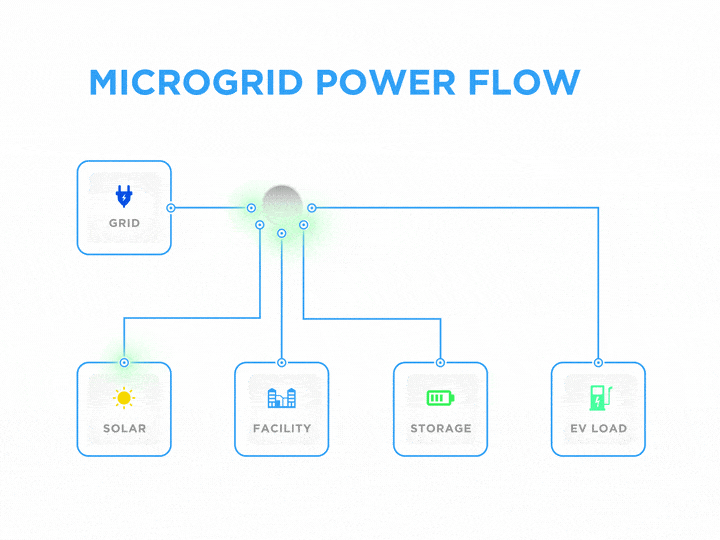About the Microgrid Infrastructure Project
The Port of San Diego initiated the Tenth Avenue Marine Terminal (TAMT) Microgrid - Resiliency in Terminal Operations project in 2016 with the objective of supporting the redevelopment and electrification of TAMT by making it a modern, clean, and more efficient terminal. This cornerstone project provides renewable, reliable, and resilient power to meet operational needs on TAMT and advances Port emissions reductions goals.
The microgrid is made possible by the California Energy Commission’s (CEC) Electric Program Investment Charge (EPIC) grant program.
Behind the Meter Microgrid
As renewable energy is generated by the 700-kilowatt solar photovoltaic (PV) array, it is stored within the 2,700-kilowatt hour lithium-ion battery energy storage system (BESS). The microgrid provides load shifting and peak shaving during normal daily operations and supports utility demand response needs. The Solar PV offsets energy loads on the terminal, when there is excess Solar PV generation, the BESS is charged. When the BESS is fully charged, excess Solar PV production is exported to the grid. If there is a power loss from the utility, the microgrid controller will re-energize the terminal’s main electrical distribution system. When there is a loss of power from the grid, the microgrid will support critical operations on the terminal in what is called an “islanded mode.”

For illustrative purposes, animation example of the microgrid power flow.
Advancing Energy and Greenhouse Gas Policies for California
The CEC EPIC program grant funding opportunity focused on demonstrating a business case for microgrids and advancing California’s energy and greenhouse gas policies in four key areas: electrification, resiliency, technological advancement, and replicability.
-
ElectrificationElectrification
Continued electrification of maritime operations helps the Port improve air quality and reduce greenhouse gas emissions (GHGs) on the terminal and within communities adjacent to the Port. This project aligns with both the Port’s Climate Action Plan and Maritime Clean Air Strategy.
-
ResiliencyResiliency
The microgrid provides backup power to critical Port-operated facilities in times of a grid outage, including security infrastructure, lights, administrative facilities, and the jet fuel storage facility without interruption which supports the Port’s role as one of 18 Strategic Ports in the United States, as designated by the Department of Transportation. As a Strategic Port, terminal staff and operations are able to support strategic military support operations within hours when needed.
-
Energy Cost SavingsEnergy Cost Savings
In normal day-to-day operations, the microgrid is anticipated to reduce energy costs by 60% at TAMT through the use of on-site electric energy generation, peak shaving, and participation in demand response programs. The initial analysis was conducted by a third party and will be analyzed as a part of the EPIC grant program.
-
Emissions ReductionsEmissions Reductions
The microgrid is anticipated to reduce the Port’s greenhouse gas emissions by approximately 360 metric tons of carbon dioxide equivalent annually, which is approximately one million miles driven by a typical passenger vehicle per year.1
1 Resource: Environmental Protection Agency Carbon Footprint calculator.
-
ReplicabilityReplicability
The objective of the microgrid is to demonstrate a model for commercially viable renewable-based microgrids that can be implemented at other ports and goods movement facilities and supports continued electrification initiatives.
-
Technological AdvancementTechnological Advancement
The microgrid aims to support the state’s statutory energy goals and technological advancement in the area of microgrid deployment through the sharing of best practices across the industry and the demonstration of a microgrid use case for maritime applications.
A Strategic Port
The Port of San Diego is one of 18 commercial Strategic Ports designated by the U.S. Department of Transportation in support of the U.S. Department of Defense.
Critical Infrastructure Powered by the Microgrid System
The microgrid increases the terminal’s readiness and provides islanding capabilities allowing critical port infrastructure to remain operational through grid outages.
- Critical Infrastructure the Microgrid Powers
- Security infrastructure
- Jet fuel storage facility
- Terminal lighting
- Key terminal facilities to support zero emissions
Our Team
- Burns & McDonnell
- University of California, San Diego
- Electric Power Research Institute
- EDF/PowerFlex
